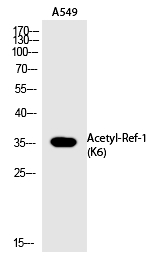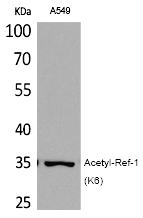

| WB | 咨询技术 | Human,Mouse,Rat |
| IF | 咨询技术 | Human,Mouse,Rat |
| IHC | 咨询技术 | Human,Mouse,Rat |
| ICC | 技术咨询 | Human,Mouse,Rat |
| FCM | 咨询技术 | Human,Mouse,Rat |
| Elisa | 1/20000 | Human,Mouse,Rat |
| Aliases | APEX1; APE; APE1; APEX; APX; HAP1; REF1; DNA-(apurinic or apyrimidinic site) lyase; APEX nuclease; APEN; Apurinic-apyrimidinic endonuclease 1; AP endonuclease 1; APE-1; REF-1; Redox factor-1 |
| Entrez GeneID | 328; |
| WB Predicted band size | 35kDa |
| Host/Isotype | Rabbit IgG |
| Antibody Type | Primary antibody |
| Storage | Store at 4°C short term. Aliquot and store at -20°C long term. Avoid freeze/thaw cycles. |
| Species Reactivity | Human |
| Immunogen | Synthesized peptide derived from the human Ref-1 around the acetylation site of K6. |
| Formulation | Purified antibody in PBS with 0.05% sodium azide,0.5%BSA and 50% glycerol. |
+ +
以下是关于Ref-1/Acetyl-Lys6(APE1乙酰化修饰)抗体的参考文献示例:
---
1. **文献名称**:*Acetylation of human APE1 regulates its repair and redox functions*
**作者**:Bhakat, K.K., et al.
**摘要**:该研究首次报道APE1在K6/K7位点的乙酰化修饰会抑制其DNA修复活性,但增强其氧化还原调控功能。研究通过特异性抗体(Acetyl-Lys6)验证了该修饰在细胞应激响应中的作用。
2. **文献名称**:*SIRT1 interacts with APE1 and regulates its acetylation status to modulate DNA repair capacity*
**作者**:Yamaguchi, T., et al.
**摘要**:文章揭示SIRT1通过去乙酰化APE1(K6位点)增强其DNA修复能力,实验中利用Acetyl-Lys6抗体证明电离辐射后该位点乙酰化水平的变化。
3. **文献名称**:*Acetylated APE1 promotes tumor progression and chemoresistance in colorectal cancer*
**作者**:Thakur, S., et al.
**摘要**:研究通过Acetyl-Lys6抗体检测发现,结直肠癌中APE1 K6乙酰化水平升高与化疗耐药性相关,提示其作为潜在治疗靶点的价值。
4. **文献名称**:*Post-translational modifications of APE1: emerging therapeutic targets in cancer*
**作者**:Hao, Q., et al.
**摘要**:综述总结了APE1乙酰化修饰(包括K6位点)的功能及其在癌症中的作用,引用了Acetyl-Lys6抗体在多项研究中的应用案例。
---
**说明**:
- Ref-1(APE1)的K6乙酰化是调控其功能转换(修复→氧化还原)的关键修饰,上述文献均涉及该位点抗体在机制或疾病研究中的应用。
- 若需具体实验细节或验证数据,建议通过PubMed/DOI进一步检索原文。
The Ref-1 (Acetyl-Lys6) antibody is a specialized tool designed to detect the acetylated form of the APE1/Ref-1 protein at lysine residue 6 (K6). APE1/Ref-1. a multifunctional protein, plays critical roles in DNA repair (as part of the base excision repair pathway) and redox regulation of transcription factors like NF-κB and HIF-1α. Acetylation at K6. a post-translational modification, modulates APE1’s subcellular localization, shifting it from the nucleus to the cytoplasm, and influences its interaction with other proteins. This modification is associated with cellular responses to oxidative stress, inflammation, and apoptosis.
The antibody is widely used in research to investigate the regulatory mechanisms of APE1 in diseases such as cancer, neurodegenerative disorders, and aging. It enables the detection of acetylated APE1 via techniques like Western blotting, immunofluorescence, and immunoprecipitation. Specific validation typically includes testing in knockout models or deacetylase inhibitor-treated cells to confirm target specificity. Understanding APE1 acetylation dynamics provides insights into its dual enzymatic functions and its role in balancing genomic stability with stress adaptation, making this antibody valuable for studies on redox signaling, DNA damage response, and therapeutic targeting of APE1-related pathways.
×